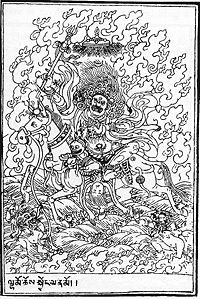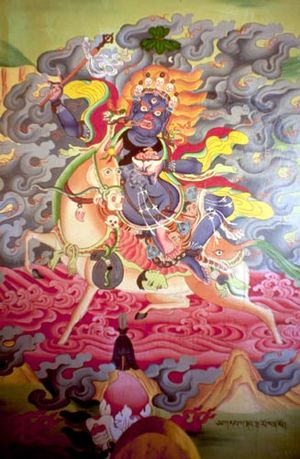
Palden Lhamo
Encyclopedia

Wylie transliteration
The Wylie transliteration scheme is a method for transliterating Tibetan script using only the letters available on a typical English language typewriter. It bears the name of Turrell V. Wylie, who described the scheme in an article, A Standard System of Tibetan Transcription, published in 1959...
: dpal ldan lha mo), Shri Devi (Sanskrit
Sanskrit
Sanskrit , is a historical Indo-Aryan language and the primary liturgical language of Hinduism, Jainism and Buddhism.Buddhism: besides Pali, see Buddhist Hybrid Sanskrit Today, it is listed as one of the 22 scheduled languages of India and is an official language of the state of Uttarakhand...
), or Ukin Tengri (Mongolian
Mongolian language
The Mongolian language is the official language of Mongolia and the best-known member of the Mongolic language family. The number of speakers across all its dialects may be 5.2 million, including the vast majority of the residents of Mongolia and many of the Mongolian residents of the Inner...
) is a protecting Dharmapala
Dharmapala
In Vajrayana Buddhism, a dharmapāla is a type of wrathful deity. The name means "Dharma-defender" in Sanskrit, and the dharmapālas are also known as the Defenders of the Law , or the Protectors of the Law, in English....
of the teachings of Gautama Buddha
Gautama Buddha
Siddhārtha Gautama was a spiritual teacher from the Indian subcontinent, on whose teachings Buddhism was founded. In most Buddhist traditions, he is regarded as the Supreme Buddha Siddhārtha Gautama (Sanskrit: सिद्धार्थ गौतम; Pali: Siddhattha Gotama) was a spiritual teacher from the Indian...
in the Gelug
Gelug
The Gelug or Gelug-pa , also known as the Yellow Hat sect, is a school of Buddhism founded by Je Tsongkhapa , a philosopher and Tibetan religious leader...
school of Tibetan Buddhism
Tibetan Buddhism
Tibetan Buddhism is the body of Buddhist religious doctrine and institutions characteristic of Tibet and certain regions of the Himalayas, including northern Nepal, Bhutan, and India . It is the state religion of Bhutan...
. She is also called Remati. She is the wrathful deity considered to be the principal Protectress of Tibet.
Palden Lhamo is the consort of Mahakala
Mahakala
Mahākāla is a Dharmapala in Vajrayana Buddhism, and a deity in Chinese and Japanese Buddhism, particularly in the Vajrayana school. He is known as Daheitian in Chinese and Daikokuten in Japanese...
and has been described as "the tutelary deity of Tibet and its government", and as "celebrated all over Tibet and Mongolia
Mongolia
Mongolia is a landlocked country in East and Central Asia. It is bordered by Russia to the north and China to the south, east and west. Although Mongolia does not share a border with Kazakhstan, its western-most point is only from Kazakhstan's eastern tip. Ulan Bator, the capital and largest...
, and the potent protector of the Dalai and Panchen Lamas and Lhasa."
Palden Lhamo and the lake Lhamo La-tso

Lhamo La-tso
Lhamo La-tso or Lhamo Latso , the small oval 'Oracle Lake', is where senior Tibetan monks go for visions to assist in the discovery of reincarnations of the Dalai Lamas. Other pilgrims also come to seek visions...
, promised Gendun Drup, the 1st Dalai Lama
Dalai Lama
The Dalai Lama is a high lama in the Gelug or "Yellow Hat" branch of Tibetan Buddhism. The name is a combination of the Mongolian word далай meaning "Ocean" and the Tibetan word bla-ma meaning "teacher"...
in one of his visions "that she would protect the reincarnation lineage of the Dalai Lamas." Ever since the time of Gendun Gyatso, the 2nd Dalai Lama, who formalised the system, the Regents and other monks have gone to the lake to seek guidance on choosing the next reincarnation through visions while meditating there.
The particular form of Palden Lhamo at the lake Lhamo La-tso is Gyelmo Maksorma, "The Victorious One who Turns Back Enemies". The lake is sometimes referred to as "Pelden Lhamo Kalideva", which indicates that Palden Lhamo is an emanation of the goddess Kali
Kali
' , also known as ' , is the Hindu goddess associated with power, shakti. The name Kali comes from kāla, which means black, time, death, lord of death, Shiva. Kali means "the black one". Since Shiva is called Kāla - the eternal time, Kālī, his consort, also means "Time" or "Death" . Hence, Kāli is...
, the shakti
Shakti
Shakti from Sanskrit shak - "to be able," meaning sacred force or empowerment, is the primordial cosmic energy and represents the dynamic forces that are thought to move through the entire universe in Hinduism. Shakti is the concept, or personification, of divine feminine creative power, sometimes...
of the Hindu
Hindu
Hindu refers to an identity associated with the philosophical, religious and cultural systems that are indigenous to the Indian subcontinent. As used in the Constitution of India, the word "Hindu" is also attributed to all persons professing any Indian religion...
god Siva
Shiva
Shiva is a major Hindu deity, and is the destroyer god or transformer among the Trimurti, the Hindu Trinity of the primary aspects of the divine. God Shiva is a yogi who has notice of everything that happens in the world and is the main aspect of life. Yet one with great power lives a life of a...
. Gyelmo Maksorma (rGyal mo dMag zor ma) or Machik Pelha Shiwai Nyamchen (Ma gcig dPal lh Zhi ba'i nyams can) is an unusually peaceful form of Palden Lhamo.
The mountain to the south of Chokorgyel Monastery
Chokorgyel Monastery
Chokorgyel Monastery is a Buddhist monastery in Gyatsa County in Tibet.-History:In 1509 Gedun Gyatso, the 2nd Dalai Lama, had a meditation cave and founded a hermitage here...
, Shridevi, is the "blue" residence of the Protectress Palden Lhamo on which a dundro or sky burial
Sky burial
Sky burial, or ritual dissection, is a funerary practice in Tibet, wherein a human corpse was incised in certain locations and placed on a mountaintop, exposing it to the elements and animals – especially to predatory birds. The locations of preparation and sky burial are understood in the...
site is located. The monastery was originally built in a triangular form to reflect the symbolism of its position at the confluence of three rivers and surrounded by three mountains and also represents the conjunction of the three elements of water, earth and fire, as well as the female principle of Palden Lhamo in the form of an inverted triangle.
Traditional accounts
It is said that, during the reign of Songtsen GampoSongtsen Gampo
Songtsän Gampo Songtsän Gampo Songtsän Gampo (Tibetan: སྲོང་བཙན་སྒམ་པོ་, Wylie: Srong-btsan sGam-po, 569–649?/605–649? was the founder of the Tibetan Empire (Tibetan: Bod; ), by tradition held to be the thirty-third ruler in his dynasty. In the Chinese records, his name is given as 'Sōngzàngānbù'...
(605 or 617? – 649), Palden Lhamo outdid all the other protector-deities in her promise to protect the king's Trulang shrine. She presented an iron cup and pledged "Erect an image of me, and I shall protect this royal shrine from any future damage by humans and mamo demons!' She is also said to have advised Lhalung Pelgyi Dorje to kill the anti-Buddhist king Langdarma
Langdarma
Langdarma was the last emperor of the unified Tibetan empire, who most likely reigned from 838 to 841 CE. Early sources named him Tri Darma meaning "King Darma"; "Lang" is a nickname meaning "ox". He was also called tsenpo or lhase Au Dunten...
in 841 CE, and is described as the 'Dharma-protectress of Lhasa'.
Description

She is the only female among the traditional 'Eight Guardians of the Law' and is usually depicted as deep blue in colour and with red hair to symbolise her wrathful nature, crossing a sea of blood riding side-saddle on a white mule. The mule has an eye on its left rump where her angry husband's arrow hit it after she killed her son (who was destined, and being raised to be the one to finally put an end to Buddhism) and used his skin as a saddle blanket. She has three eyes and is often shown drinking blood from a human skull.

